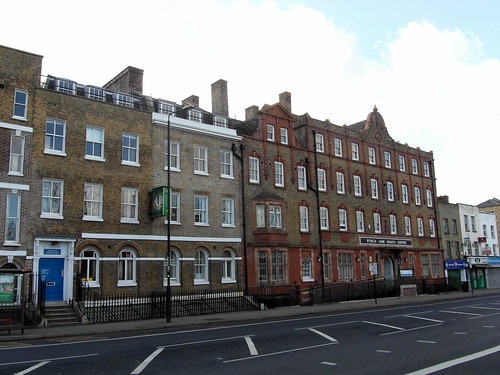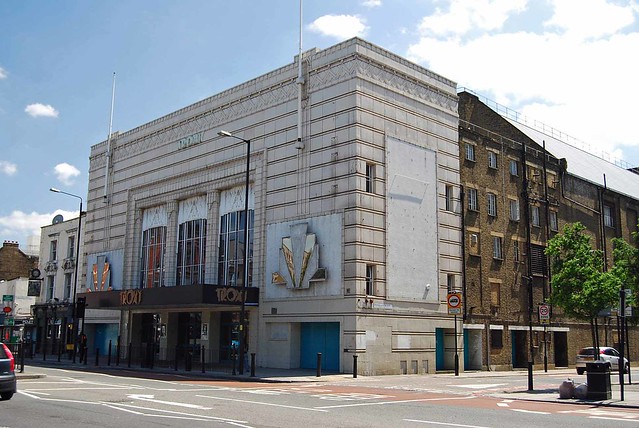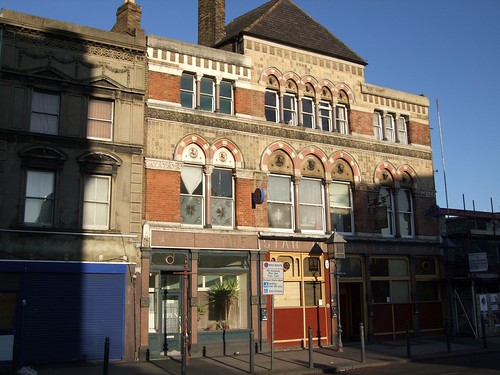I had a lunch meeting in the City and a bit of time to spare before another meeting in Canary Wharf, so I decided to walk. The straightest route, from Aldgate to Cabot Square, is more or less on the Commercial Road, as busy a street as you can want, and filled with rather shabby shops and rundown godowns and so on. It is a rather old thoroughfare, though, and an observant perambulator can see a thing or two worth looking at.
So this was my route:
View Larger Map
First, you must know that the Commercial Road was cut through the East End in the early 19th century by the East India Company.
Almost the first thing of importance on the way is the Proof House of the Worshipful Company of Gunmakers. The Company was established in 1637; unlike other livery companies of the City, this was always situated outside the City walls, probably because of the noise of its 'proof' procedures. (Proofing was the testing of the safety of gun barrels.) The company acquired the property in a 'physic' garden in Whitechapel in 1675, which is now 46-50 Commercial Road. The original Proof House was damaged by explosions and rebuilt after 1757.1
Almost the first thing of importance on the way is the Proof House of the Worshipful Company of Gunmakers. The Company was established in 1637; unlike other livery companies of the City, this was always situated outside the City walls, probably because of the noise of its 'proof' procedures. (Proofing was the testing of the safety of gun barrels.) The company acquired the property in a 'physic' garden in Whitechapel in 1675, which is now 46-50 Commercial Road. The original Proof House was damaged by explosions and rebuilt after 1757.1
 |
| Gunmakers' Company Proof House |
Further along is the Synagogue of the Congregation, incorporating several Jewish strands - the Bikur Cholim and the Yevra Isroyel. The congregation was founded in 1904, comprising Lithuanian and Polish Jewish immigrants. Today, much of the congregation consists of local Jews as well as Jews from India and Germany. The synagogue was consecrated in 1921 after an internal redecoration by Lewis Solomon and Son, but was for a long time unused. After extensive renovations in 2004, it appears to be thriving again. I didn't see the interior, but it's supposed to be rather pretty.2
It appears that the first Baxter (Henry William) was hairdresser next door to the pub (founded in 1845), and he took over in 1871. There were still Baxters ruling the pub in 1915.13 The Star of the East, Commercial Road, unusually has a fancy polychromed Gothic frontage, no doubt intended to attract drinkers from the nearby docks.14 The pub was closed in 2008 and was a restaurant for a while, and now there's chatter that it's a pub again, but I saw no evidence of activity as I nipped by.
Across the pub is the British and Foreign Sailors' Hostel - yet another charitable construction by that worthy Passmore Edwards - which opened in 1901.15 This was recognised for the quality of the accommodations provided to sailors from across the British Empire. It is an Edwardian building, Art Nouveau in spirit, a welcoming gateway in form, and fluently carved with maritime symbols,16 including Britannia as a ship's figurehead. There are also various inscriptions, some faded more than others. You can see a bunch of pictures of the building and its features on Maggie Jones' Flickr set.17 Over the years, the building has had many popular names: Sailors' Palace, Jack's Palace, Mariners' Hotel...
At this point, I had to leave Commercial Road and get onto the West India Dock Road, and as I had already dawdled a bit and was running late for my meeting, I jumped onto a bus.
Other interesting sights that I missed:
The George Tavern.
The Original Chinatown: most of it was demolished following rioting and anti-Chinese agitation in the 1930s. To be fair, much of it was spread across Limehouse, and few traces remain on the Commercial road itself.
References
Continuing along my merry way, I saw the Steel's Lane Health Centre. This used to be the East End Maternity Hospital (1889-1968), which began as a Mother's Home at Number 394, and then gradually took over the rest of the block.
It is architecturally notable for its windows with terracotta mullions and canted bays at either end. A chapel with trefoil-headed windows survives at the rear.3, 4 Above the main entrance to the clinic is a plasterwork figure with a cross. There is also a bright green clock with Roman face and gilt-edged, on which appears the legend 'East End Maternity Hospital'.
Next! I saw a blue plaque celebrating Victor Andrew de Bier McLaglen (1886-1959), a UK-born boxer and Hollywood actor. I hadn't heard of him, but it appears that he won an Academy Award in 1935 for the film The Informer (directed by John Ford). Here he is with Cary Grant in Gunga Din.
At 490 Commercial Road is a large Art Deco edifice called Troxy. It was designed by George Coles and opened as a cinema in 1933, seating 3520 people. It was built on the site of an old brewery; it was fashionable and luxurious and showed the best films. It even had an organ in the orchestral pit that would play the latest tunes during the interval. The cinema operated from its first film (King Kong) to its last (The Siege of Sydney Street) for 27 years. Later on, it served as a rehearsal space for the Royal Opera House and as a bingo centre. Today it's been restored to its Art Deco glory and serves as a multipurpose venue.
As I approached Limehouse Station, I noticed a set of row houses on White Horse Road. This street is quite old: it was till modern times the only northerly route from the Thames through the East End. The area, historically, used to be the hamlet of Ratcliff. Until the 19th century, it appears that there were several large houses with spacious gardens, in which lived captains and others related to the shipping industry.5 The current terraces are not in any way distinctive, and the street has little else to recommend itself (other than a little graveyard at the corner with Salmon Lane - which I didn't walk up to), so I shall linger here no longer.
A problem with Commercial road is that it is, in fact, very commercial, and not pretty at all. There are many properties derelict, businesses shuttered, squats. It might have been more interesting to walk around the squares and residential parts of the East End and Limehouse. I was in a hurry, however, and continued to propagate rectilinearly.
The next notable building is The Passmore Edwards Limehouse District Public Library. It is closed and derelict. It was founded in 1900 by Passmore Edwards, a newspaperman and philanthropist,6 who also created several other buildings to succour the East End. The library closed in 2003, was sold to a restaurant company,7, 8 and has still not been put to any use.
A little further along is the Limehouse Town Hall, which doesn't look in great shape either. It was built in 1879. 9 I learned that when several parishes were amalgamated into the London Borough of Tower Hamlets, this building (along with the Poplar and St George's town halls) became surplus to requirements. It has housed various organisations over the years; these days it's being renovated as a cultural space, and was, in fact, opened to the public during this year's Open House Weekend.
The lovely St Anne's Church is the next building on this potted tour. Designed by Nicholas Hawksmoor, it was consecrated in 1730, ruined by fire in 1850, restored shortly thereafter, and underwent a complete refurbishment between 1999-2009. It has deep connections with the Royal Navy: its clock was designed to guide shipping on the Thames, chiming every fifteen minutes.10 These days it chimes hourly, and no, I didn't hear it.
 |
| Steel's Lane Health Centre, by Tom Bastin, on Flickr. |
It is architecturally notable for its windows with terracotta mullions and canted bays at either end. A chapel with trefoil-headed windows survives at the rear.3, 4 Above the main entrance to the clinic is a plasterwork figure with a cross. There is also a bright green clock with Roman face and gilt-edged, on which appears the legend 'East End Maternity Hospital'.
_trailer_1.jpg) |
| Victor McLaglen and Cary Grant in Gunga Din. |
Next! I saw a blue plaque celebrating Victor Andrew de Bier McLaglen (1886-1959), a UK-born boxer and Hollywood actor. I hadn't heard of him, but it appears that he won an Academy Award in 1935 for the film The Informer (directed by John Ford). Here he is with Cary Grant in Gunga Din.
 |
| Troxy Art Deco Cinema, by Maggie Jones, on Flickr. |
At 490 Commercial Road is a large Art Deco edifice called Troxy. It was designed by George Coles and opened as a cinema in 1933, seating 3520 people. It was built on the site of an old brewery; it was fashionable and luxurious and showed the best films. It even had an organ in the orchestral pit that would play the latest tunes during the interval. The cinema operated from its first film (King Kong) to its last (The Siege of Sydney Street) for 27 years. Later on, it served as a rehearsal space for the Royal Opera House and as a bingo centre. Today it's been restored to its Art Deco glory and serves as a multipurpose venue.
As I approached Limehouse Station, I noticed a set of row houses on White Horse Road. This street is quite old: it was till modern times the only northerly route from the Thames through the East End. The area, historically, used to be the hamlet of Ratcliff. Until the 19th century, it appears that there were several large houses with spacious gardens, in which lived captains and others related to the shipping industry.5 The current terraces are not in any way distinctive, and the street has little else to recommend itself (other than a little graveyard at the corner with Salmon Lane - which I didn't walk up to), so I shall linger here no longer.
A problem with Commercial road is that it is, in fact, very commercial, and not pretty at all. There are many properties derelict, businesses shuttered, squats. It might have been more interesting to walk around the squares and residential parts of the East End and Limehouse. I was in a hurry, however, and continued to propagate rectilinearly.
The next notable building is The Passmore Edwards Limehouse District Public Library. It is closed and derelict. It was founded in 1900 by Passmore Edwards, a newspaperman and philanthropist,6 who also created several other buildings to succour the East End. The library closed in 2003, was sold to a restaurant company,7, 8 and has still not been put to any use.
 |
| Limehouse Town Hall in 1937 |
 |
| St Anne's Limehouse, painted by Noel Gibson (via Spitalfields Life). |
The clock in the tower is still the highest church clock in London, had the first illuminated clock face in the country, and its elevation enabled it to be seen by the thousands of ships which moored every day in the surrounding docks.11The Star of the East pub is the penultimate building on my walk: it has a a couple of gas street lamps in front of it. I don't know if these are still lit or not. The pub was run by the Baxter family for years.12
 |
| The Star of the East pub, by Ewan Munro, on Flickr. |
Across the pub is the British and Foreign Sailors' Hostel - yet another charitable construction by that worthy Passmore Edwards - which opened in 1901.15 This was recognised for the quality of the accommodations provided to sailors from across the British Empire. It is an Edwardian building, Art Nouveau in spirit, a welcoming gateway in form, and fluently carved with maritime symbols,16 including Britannia as a ship's figurehead. There are also various inscriptions, some faded more than others. You can see a bunch of pictures of the building and its features on Maggie Jones' Flickr set.17 Over the years, the building has had many popular names: Sailors' Palace, Jack's Palace, Mariners' Hotel...
At this point, I had to leave Commercial Road and get onto the West India Dock Road, and as I had already dawdled a bit and was running late for my meeting, I jumped onto a bus.
*****
Other interesting sights that I missed:
The George Tavern.
The Original Chinatown: most of it was demolished following rioting and anti-Chinese agitation in the 1930s. To be fair, much of it was spread across Limehouse, and few traces remain on the Commercial road itself.
References
- Street Directory of the Commercial Road, south side, 1921.
- Congregation of Jacob Synagogue, by David Brandes.
- Bridget Cherry, Charles O'Brien and Nikolaus Pevsner (2005). London 5: East. p. 526.
- East End Maternity Hospital, on the Lost Hospitals of London website.
- Sidney Maddocks (June 1935), 'White Horse Street', in The Copartnership Herald, vol V, no. 52.
- Dean Evans (February 2013), 'Passmore Edwards in the East End', Spitalfields Life.
- Poplar Conservatives, 'Mayor Rahman Sells Off Limehouse Library - What Next?', July 2012.
- Passmore Edwards Centennial: Libraries.
- Kieran (Sep 2011), 'Limehouse Town Hall', Secret London.
- St Anne's Limehouse: History.
- Hugo Marchant (2012), 'St Anne's Church Limehouse', in his website I'm visiting London.
- Eric Pemberton's Postcards - Limehouse, on the Isle of Dogs Life blog.
- Star of the East pub, Limehouse, listing in Pubshistory.com
- Bridget Cherry, Charles O'Brien and Nikolaus Pevsner (2005). London 5: East. p. 79.
- Sailors' Place, on Exploring East London's website.
- Bridget Cherry, Charles O'Brien and Nikolaus Pevsner (2005). London 5: East. p. 77.
- Maggie Jones, Edwardian Buildings in London 1902-1910.



2 comments:
great walk - the Gentle Author would love it
Enjoyed the read.
In 1864, my grandfather was born in a house on the corner of Rich Street, opposite The Star of the East. At that point, his grandparents (Rushbook) owned the pub. On the death of Louisa Rushbook, her husband James sold the pub to the neighbours (Baxter). My grandfather left the East End in 1900.
Post a Comment